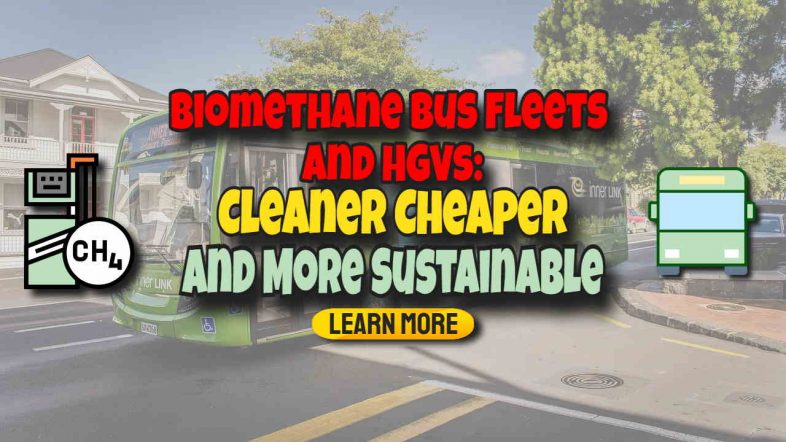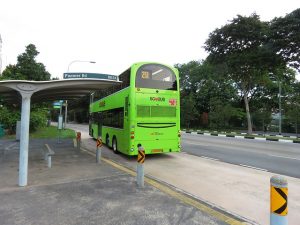The era of the biomethane bus has arrived in the UK as biomethane-powered buses and HGVs are also proving to be cleaner (satisfying Inner City Clean Air Act requirements) than diesel, cheaper to run and a lot more sustainable.
Why a Biomethane Bus is So Much Better than Diesel Powered
Biomethane has great potential as an alternative energy source for transportation vehicles, particularly to replace fossil fuels, but also for its lower emissions delivering cleaner inner-city air.
Despite the fact that its utility has been known for some time, biomethane production has only recently begun. Its adoption is being driven by rising natural gas and electricity prices, as well as the need to reduce city air pollution and mitigate the threat of global climate change.
Biomethane is a low-carbon, renewable, cost-effective alternative to diesel for HGVs that is approximately 35% to 40% cheaper and can reduce carbon emissions by up to 90%.
The fact that specialist companies, truck manufacturers, and hauliers are continuing to invest in biomethane technology and in biomethane bus fleets is a testament to the reliability of this fuel technology. It will also ensure that the fuel remains a key component of the alternative fuel landscape for many years to come.
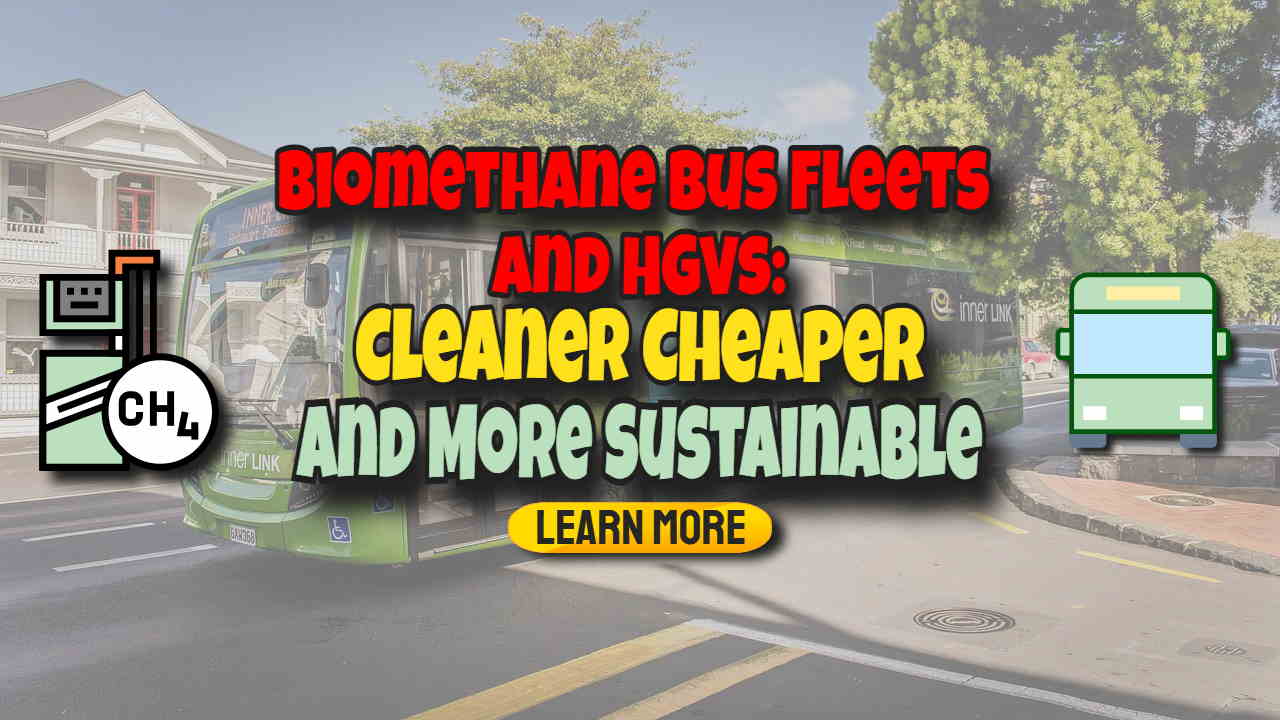
How Does a Biomethane Bus or Truck Work?
This biomethane bus or truck runs on methane, which is created by compressing renewable natural gases. Renewable natural gas is a byproduct of animal waste.
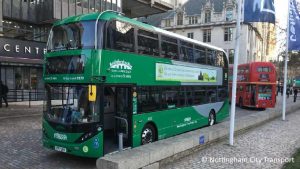
The biogas comes from:
- cow manure
- whole crop including the plant or just the crop waste
- sewage sludge from wastewater treatment.
The methane is produced using the anaerobic digestion process, and the gas is liquefied and used as fuel for the service buses. It is kept in some bus models in chambers on the bus's roof.
Interchangeability of Injection Quality Compressed Renewable Natural Gas with Grid Supplied Natural Gas
Natural gas is a fossil fuel sourced in the UK from the North Sea and European gas fields. Biomethane is a renewable natural gas that is produced through the anaerobic digestion of organic waste products such as farm slurry and food waste.
Biomethane buses can be powered by both natural gas and biomethane. These buses have a spark-ignition engine and tanks on the roof that store compressed natural gas or biomethane.
CNG and bio-methane are fundamentally the same fuel – methane – derived from either fossil or renewable sources.
Anglian Bus Company's Biomethane Fuelled Fleet
A consortium led by engineers at the University of East Anglia (UEA) launched the first biomethane-powered bus in the United Kingdom.
The dual-fuel diesel-biomethane-powered bus made its public debut at LCV 2009, during a UK exhibition of low-carbon vehicle technology held at Bedfordshire's Millbrook Proving Ground.
The new bus was developed by a consortium led by the UEA's Low Carbon Innovation Centre (LCIC), which included independent bus operator Anglian Bus, bus manufacturer Optare, and Nottingham-based engine conversion specialist Hardstaff Group.
The dual-fuel vehicle is a standard Anglian Bus Optare Solo single-deck diesel midibus. Originally powered entirely by diesel, the Mercedes-Benz engine was modified to run on biomethane for 60% to 80% of the time.
Things have moved on, the original experiment proved the concept and Nottingham now has a full fleet of biogas-powered double-decker buses.
The fleet, which cost £17 million, is currently (in 2021) the world's largest fleet of biogas vehicles.
The Bristol Bio-Bus
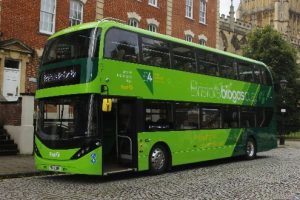
The Bio-Bus is also claimed to be the first bus in the United Kingdom to run on gas derived from food, sewage, and commercial liquid waste.
The bus travelled over 300 kilometres on a full tank of gas (stored on the roof), an amount of fuel equivalent to the annual food and sewage waste of only five passengers. The bus's distinctive livery depicts the source of the fuel that powered it.
Biomethane bus fuel utilises a natural process known as anaerobic digestion (AD). Organic waste degrades in anoxic environments, producing methane-rich biogas. This biological phenomenon can be harvested and optimised for biomethane production through anaerobic digestion.
In addition to reducing global reliance on fossil fuels, the widespread use of gasoline-powered vehicles has the potential to significantly improve urban air quality and reduce the number of health problems associated with exposure to air pollution.
The new buses, which use Scania chassis built in the UK, will reduce emissions by 85% while also providing customers with an “improved onboard experience,” according to First, with comfortable interiors, USB charging points, and more wheelchair space.
New Bristol Biomethane (Gas) filling Station
Bristol City Biobus is putting the West of England at the forefront of clean commercial fleets. With the opening of the new fuel station made from food waste, 99 buses in the area will be running on biomethane by April 2020. Each bus will be able to travel approximately 250 miles
Gas Bus Alliance designed and built the new gas filling station, which cost around £2 million and took nine months to complete. It can produce enough compressed biomethane to power up to 100 gas buses. The biomethane is drawn directly from the mains, eliminating the need for road tankers to transport the fuel.
The £960,000 Bedminster station will provide fuel storage and easier refilling at the pumps for the city's 22 biomethane gas-powered buses.
The Gas Bus Alliance provides biomethane, which is derived from food waste via anaerobic digestion. The scheme has received a total investment of £28 million over three years, which has been partially funded by a government grant of £4.79 million through South Gloucestershire and Bristol City councils under the Low Emission Bus Scheme (LEBS).
Bristol City Biomethane Bus Benefits
 Bristol is making significant progress in dramatically improving air quality while remaining affordable, deliverable, and operationally reliable. Reliability is assured because bio-methane gas buses rely on well-known and tested technical equipment.
Bristol is making significant progress in dramatically improving air quality while remaining affordable, deliverable, and operationally reliable. Reliability is assured because bio-methane gas buses rely on well-known and tested technical equipment.
Biomethane is a natural gas that is created by decomposing organic materials such as food waste and manure.
It was in November 2014, that the [claimed] UK's first “Bio-Bus”/ biomethane bus powered by sewage and food waste debuted in Bristol.
The “poo bus” was originally powered solely by biomethane gas generated at Avonmouth's sewage treatment works. However, as the number of biogas-powered buses on the road grows, these bus models are increasingly reliant on food waste to meet demand.
The new station, located at the Bristol Community Transport (BCT) bus depot, will fuel buses on the m1 Metrobus route, which is operated by BCT under contract to First Bus.
Why Biomethane for Buses and Heavy Good Transport is Best
Analysis of various alternative fuels reveals that biomethane is the most efficient biofuel because the only other renewable fuel bioethanol, does not provide the same environmental benefits, in addition to other ethical concerns regarding bioethanol production which uses (e. g. maize) food crops.
The use of biomethane as a fuel for vehicles in public transportation clearly creates an appealing environmentally closed loop: this means that city-dwellers themselves supply the resources required for the fuel production of their own public transportation by producing organic waste.
According to Swedish SL, biogas is the best option because it is the cleanest fuel available today.
Biomethane Bus Fleets and HGVs Proven Cleaner Cheaper and More Sustainable
Why Install a Biogas Plant
The main advantages of installing a biogas plant to make biogas are twofold:
- First, it provides a solution for businesses on what to do with waste material, which can be an expensive business to get rid of, and second,
- it can actually turn the problem into a money-spinner.
Companies can produce useful biogas instead of paying for the safe disposal of waste material, which can be anything biodegradable, such as food industry trimmings.
They can then burn this to generate electricity, hot water, or heat, lowering their energy bills, or selling it to be injected into gas supply pipelines.
 The net emissions from a biomethane-powered bus are zero because the carbon came from the atmosphere rather than fossil fuels, but electricity is used at the sewage treatment plant to convert waste gas into fuel for the buses. Taking the electricity used to generate the fuel into account, Oslo City Council calculates that carbon emissions per bus are 18 tonnes per year, saving 44 tonnes of CO2 per bus per year.
The net emissions from a biomethane-powered bus are zero because the carbon came from the atmosphere rather than fossil fuels, but electricity is used at the sewage treatment plant to convert waste gas into fuel for the buses. Taking the electricity used to generate the fuel into account, Oslo City Council calculates that carbon emissions per bus are 18 tonnes per year, saving 44 tonnes of CO2 per bus per year.
Heavy-duty vehicles are major contributors to global warming emissions. Biomethane, a potential natural gas substitute derived from organic matter decomposition, has been proposed as a lower-carbon alternative to diesel for heavy-duty vehicles. But how much of a difference can it make?
The Good News and the Not So Good
The good news is that biomethane provides an excellent way to reduce global warming emissions from landfills, wastewater treatment plants, and dairies, all of which produce significant amounts of methane that is currently largely uncaptured.
The bad news is that biomethane from waste is limited by the volumes which can be produced, in comparison to existing energy power stations and fuel use. We shouldn't encourage creating more waste than we already do just to feed these new digesters.
European Union and its Member States Pledge
In recent years, the European Union and its Member States have also pledged to reduce greenhouse gas (GHG) levels through the Paris Agreement (UNFCCC 2016) and the Green New Deal (European Commission 2019).
These initiatives have pushed for the creation and expansion of policies that directly target urban buses in order to create a cleaner and more sustainable sector. The European Commission (2020) has clearly stated an agenda to reduce transport sector emissions to zero by 2050.
The importance of local public transportation will grow in the future (Spielmann et al. According to PWC (2016), one of the global economy's megatrends is “accelerating urbanisation.” An increase in urban traffic is expected as a result of urbanisation; this will have a dramatic impact; in fact, cities account for nearly 80% of global surface traffic.
Nitrogen Dioxide Compliance Announced
The Department of Environment, Food, and Rural Affairs recently announced that it was planning a nitrogen dioxide compliance move that would be implemented in all towns and cities across the country.
That means local governments would have to take steps to reduce nitrogen dioxide levels in the air, and reducing emissions from public transportation vehicles would be a big part of that. A biomethane bus emits many times less nitrogen dioxide than a normal bus.
A £225 million fund is available to assist these authorities in making the necessary changes.
Light Goods Vehicles (LGVs) & Heavy Goods Vehicles

Although Light Goods Vehicles (LGVs) would be exempt from this scheme if it were implemented (at least initially), it would be appealing to haulage companies and drivers to be able to operate heavier vehicles, which they would be permitted to do.
Heavier loads will always appeal to LGV companies because they can transport more goods at once, providing better value to their clients and allowing them to be more flexible. As a result, market competition would be the most effective tool for making HGVs more environmentally friendly.
Biomethane upgraded for vehicle use can be produced from waste for USD 0.45-0.55/LGE and USD 0.65-0.75/LGE when maize silage is added.
In Europe today, the price of biomethane can be up to 30% lower than the price of natural gas. Biomethane can be produced for as little as €55/MWh, whereas natural gas costs around €80/MWh, not including CO2 prices. This renewable gas will most likely remain less expensive than natural gas in the short and long term. Other renewable gases, such as green hydrogen, take time to scale up and are still 2-4 times more expensive, but biomethane to fuel biomethane bus fleets will be available and scalable within the next 8 years.
Large-scale production necessitates the acquisition of feedstocks (e.g. The cost of upgrading to biomethane must be added to the cost of producing biogas, but this typically accounts for only 5-10% of the total cost. The main impediment to increased biomethane use is the requirement for a dedicated gas-based refuelling network, as well as the relatively limited quantities of waste feedstocks relative to total transport demand.
Road Transport: The Cost of Renewable Solutions, a costing study conducted by IRENA, finds an increasingly positive outlook for the use of renewable energy in road transport by 2020 and beyond. courtesy of www.irena.org
We have archived below the original article which we published on this subject in July 2017 when the issue was all about giving preference to using biomethane for HGVs and buses, instead of making electricity with the limited amount of this renewable methane gas being created in biogas plants.
The case that the sections below make for prioritising the available biomethane for use in powering HGVs and Buses is as strong today as it was 5 years ago when we first published this:
ADBA Press Release:
Prioritise Biomethane for HGVs & Buses Within UK Clean Air Strategy – say ADBA
“Prioritising Biomethane for HGVs and Buses Within UK Clean Air Strategy say ADBA, Should be an Immediate UK Government Goal”
The UK government has just announced plans to phase out petrol and diesel vehicles from the UK. This is going to bring into sharp focus the need for rapid development in many directions for transport, over the next 20 plus years, from the car technology we will drive, to the infrastructure for refuelling.
Not least there will be an increased demand for renewable fuels. So, the news must be good for the biogas industry, and the bigger focus on renewable energy it will bring.
On this blog, we bring you a round-up on the news for biomethane in light of this announcement.
Biomethane is ideal for powering very low-emission vehicles.
ADBA Urges Government to Prioritise Biomethane for HGVs & Buses
UK trade body, the Anaerobic Digestion and Bioresources Association (ADBA), has called on the government to make the fuelling of busses and heavy goods vehicles with clean biomethane central to its Clean Air Strategy (i. e. prioritise Biomethane for HGVs).
The organisation explained that biomethane is a low-carbon transport fuel produced by the anaerobic digestion (AD) of organic wastes to create biogas which can then be upgraded to create a methane-based fuel.
According to ADBA, the UK AD industry already has sufficient capacity today to produce enough biomethane to power the UK’s entire bus fleet, and the use of biomethane for buses and HGVs has increased in recent years in response to concerns over the cost of fossil-fuel-based fuels and their negative impact on air quality and greenhouse gas emissions.
via ADBA Urges Government to Prioritise Biomethane for HGVs & Busses
Biofuels – Biomethane must be central to UK Clean Air Strategy say ADBA
Biomethane is a low-carbon transport fuel produced by anaerobic digestion (AD), a natural process that breaks down organic wastes and purpose-grown crops to create biogas that can then be upgraded to create a methane-based fuel.
The UK AD industry currently has sufficient capacity to produce enough biomethane to power the UK’s entire bus fleet (Biomethane for HGVs), and the use of biomethane for buses and HGVs has increased in recent years in response to concerns over the cost of fossil-fuel-based fuels and their negative impact on air quality and greenhouse gas emissions. For instance, in May, Nottingham City Transport’s unveiled a new £17 million double-deck ‘Bio-Gas’ bus fleet, the largest of its kind in the world.
ADBA’s call to arms comes as the Department for Environment, Food and Rural Affairs (DEFRA) have today (26 July 2017) published its plan to deliver nitrogen dioxide compliance in UK towns and cities, part of a wider Clean Air Strategy due to be published in 2018. The measures unveiled by DEFRA include £255 million of funding for local authorities to crack down on roadside emissions, including from busses and other types of public transport.
Local councils will be required to produce local air quality plans that reduce nitrogen dioxide levels in the fastest possible time, while local authorities will be able to bid for money from a new “Clean Air Fund” to support improvements that will reduce the need for restrictions on polluting vehicles.
This could include helping to fund upgraded biomethane bus fleets.
The new measures announced also include the right for van drivers to use heavier vehicles if they are electric or gas-powered.
“The use of biomethane derived from well-managed feedstocks as vehicular fuel can help to reduce the scandalous levels of air pollution we see in towns and cities across the UK, costing thousands of lives each year,” said ADBA Chief Executive Charlotte Morton.
“Local authorities reading the Government’s air quality plans now have the perfect opportunity to follow the example of Nottingham City Transport and others in rolling out biomethane-fuelled municipal bus fleets, which can make huge improvements to air quality in the UK’s towns and cities.
Over the short to medium term, biomethane presents the only practical means of decarbonising HGVs, buses and non-road mobile machinery.
While biomethane has the potential to power every HGV in the country and some pioneers have grasped this opportunity, far more support is needed from the UK government to make it easier for others to follow their example.
It’s critical that the Government urgently delivers a robust response to the Renewable Transport Fuel Obligation consultation that concluded in January. Long-term support for AD is crucial for reducing emissions from the difficult-to-decarbonise transport sector and for improving air quality in our cities and towns to save lives.”
To reflect the growing interest in low-carbon fuels such as biomethane, ADBA will be hosting the third UK Biomethane and Gas Vehicle Conference on 28 September 2017 at the Queen’s Hotel in Leeds, bringing together transport, fuel infrastructure, freight, and logistics professionals and local authorities to share the benefits of biomethane and discuss what is required to stimulate and grow the market. via Biomethane must be central to UK Clean Air Strategy say ADBA
The Anaerobic Digestion and Bioresources Association (ADBA … outlines steps to be taken to reduce emissions of Nitrogen Dioxide across the UK. Under the plan, local authorities are expected to deliver local proposals to clean up the air within their local areas.
Renewables
 Also commenting on the government’s plan, James Court, head of policy and external affairs at the Renewable Energy Association, backed plans for increased use of renewables in the transport fuel mix.
Also commenting on the government’s plan, James Court, head of policy and external affairs at the Renewable Energy Association, backed plans for increased use of renewables in the transport fuel mix.
He said: “The government can also take steps to reduce carbon emissions and urban pollution today by increasing the quantity of renewable biofuels in the petrol mix.
“The UK’s renewable fuel industry supports over 10,000 jobs and has attracted more than a billion pounds of investment in the UK’s renewable fuel manufacturing infrastructure, and is critical during the transition towards an electrified fleet.”
Mr Court emphasised that electric vehicles will be an essential part of the future energy system that can “improve air quality, decarbonise transport and optimise the UK’s energy infrastructure”.
But we need government action to use renewable energy to power electric vehicles, and ensure a “genuinely decarbonised sector”.
via Renewable energy in Clean Air Plan
ADBA and REA have called on the government to increase the use of renewable biomethane to fuel vehicles, as part of efforts to tackle air pollution in the UK.
Yesterday (26 July), the government published a national plan for tackling roadside Nitrogen Dioxide concentrations as part of its upcoming Clean Air Strategy due in 2018. The latest policy proposals aim to fight air pollution at a local level and include a commitment to end the sale of new diesel and petrol-only vehicles from 2040.
Under the government’s plans, local authorities are expected to deliver plans to clean up their air within the next eight months. The government is offering funding support for changes such as retrofitting and low-emission biomethane bus technology.
via AD biogas ‘can help air quality crisis’
[First published July 2017. Updated July 2022.]

